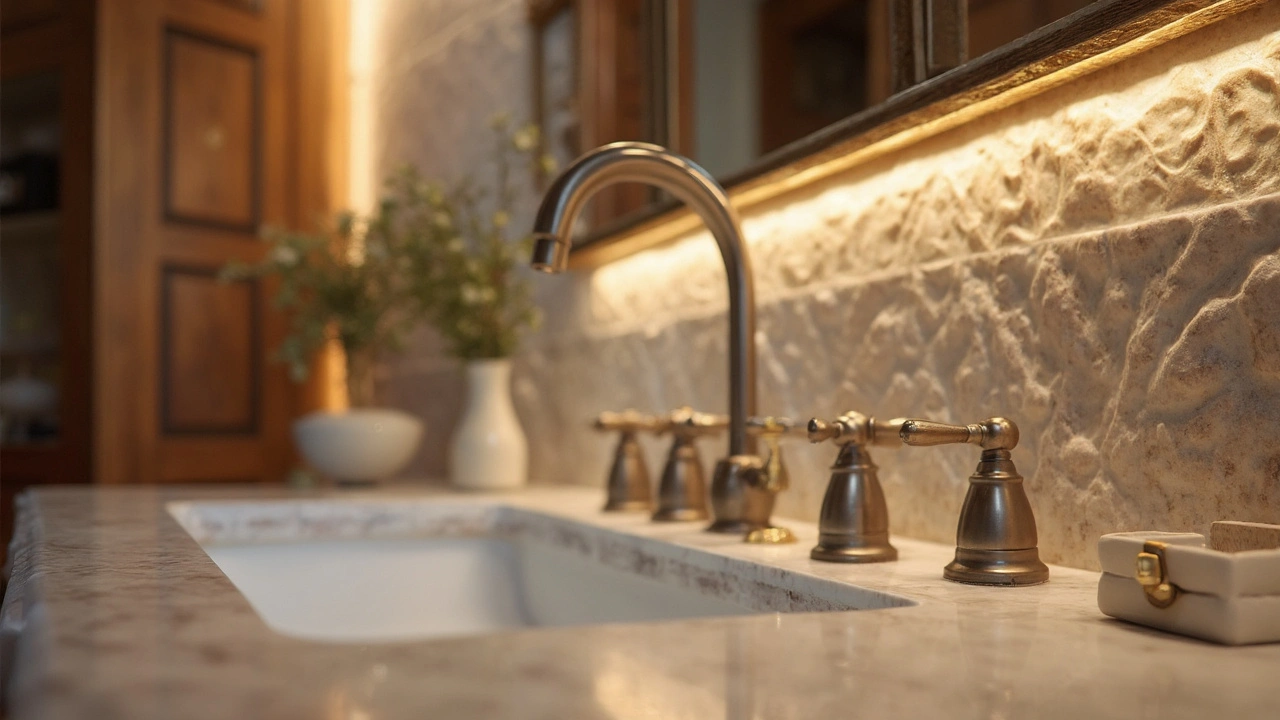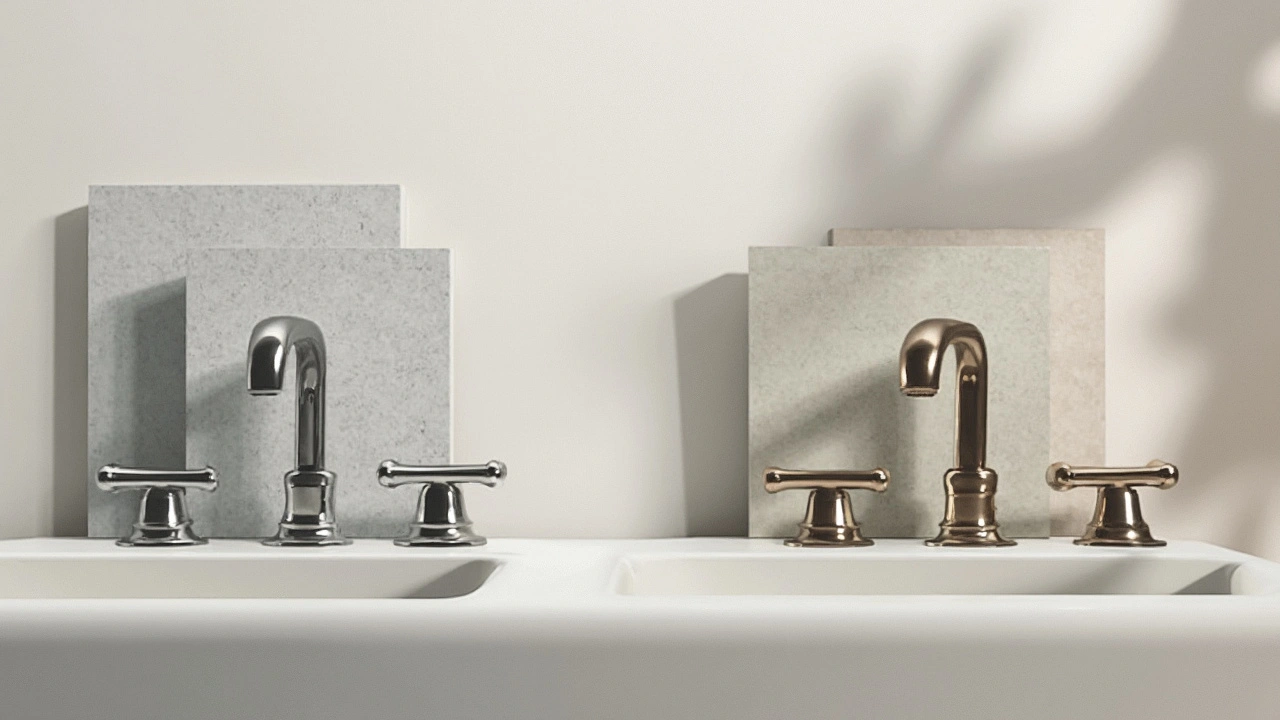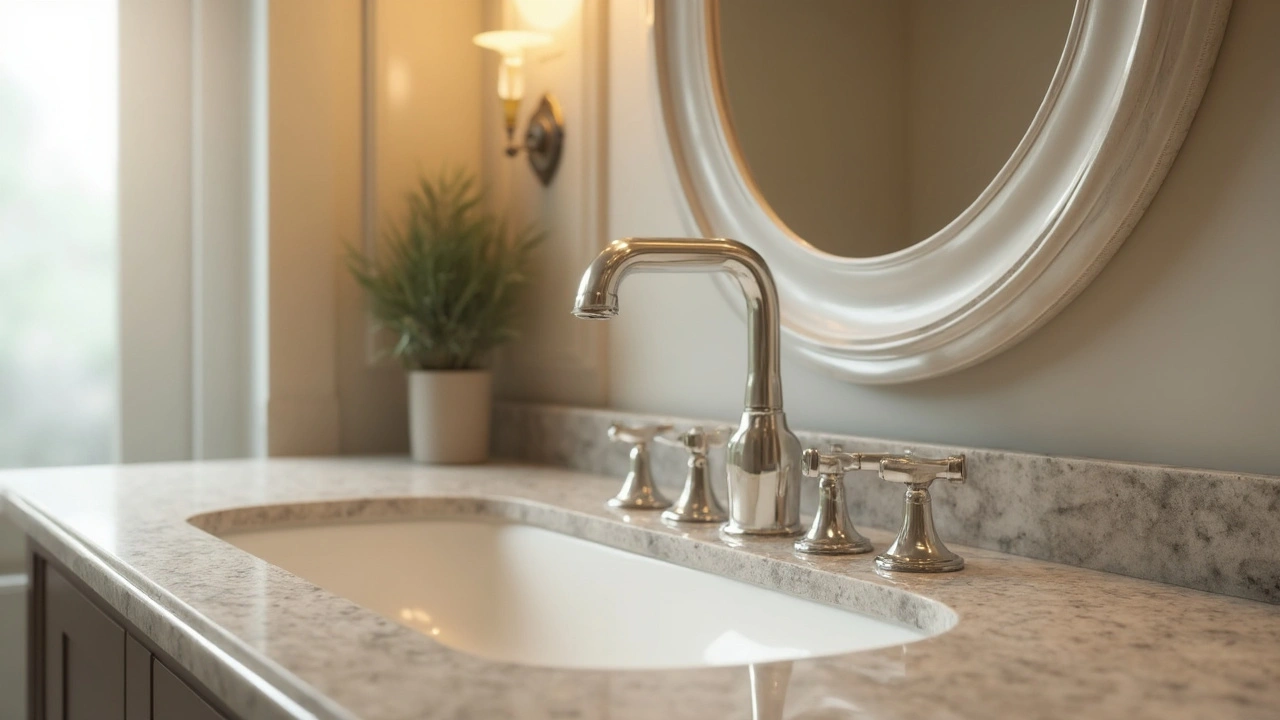When it comes to remodeling your bathroom, the color of your faucets might seem like a tiny detail, but it’s one that packs a punch. Picture this: you're standing in a beautifully designed bathroom, the perfect marriage of functionality and style. What ties it all together? The faucets. They can elevate the space—when you choose the right color, that is.
So, what's the secret sauce for selecting a faucet color that's not just a flash in the pan? Well, it often boils down to hues that have stood the test of time. Colors like polished chrome and brushed nickel are the MVPs here, known for blending seamlessly with both modern and vintage designs. Imagine the easy maintenance and that classic vibe that never feels outdated.
If you're aiming for something with a bit more contrast, matte black is also making waves. It’s the cool kid on the block, bringing in a modern edge while being discreetly confidence-boosting. And let's not leave out the warm tones of gold and brass, which add just the right touch of luxury and warmth without screaming for attention.
Next time you're planning your renovation, remember: the finishing touches are more than just an add-on. They’re the cherry on top, the sprinkle of magic that turns a nice bathroom into a timeless one.
- The Undeniable Charm of Chrome
- Timeless Appeal of Brushed Nickel
- How Matte Black Earned Its Stripes
- The Warmth of Gold and Brass Tones
- Tips for Choosing the Right Finish
The Undeniable Charm of Chrome
Ah, polished chrome. It's like the little black dress of faucet colors: always in style, reliably elegant, and effortlessly chic. Chrome has been a go-to finish for ages, and there’s good reason it remains a staple in bathroom design.
First off, it’s all about versatility. Chrome works well in various settings, whether you're dreaming of a minimalist modern space or something with a classic vibe. It blends seamlessly with pretty much any color scheme, making it a safe bet if you’re indecisive or planning on switching up your decor often.
And let’s talk about care. Known for its reflective surface, chrome can be a fingerprint magnet, but it’s super easy to clean. A quick wipe with a damp cloth and voilà, it’s sparkling again! Unlike some finishes that show water spots like it's their job, chrome tends to disguise them better, making it look impeccable with minimal fuss.
Chrome is also a cost-effective choice. It's usually more affordable than finishes like nickel or gold, so you won’t break the bank achieving that stylish look. Yet despite the lower price tag, it doesn’t skimp on quality. Chrome is durable, standing up to wear and tear without losing its shine or luster over time.
For those who love a bit of tech, chrome plays well with smart home features too. Picture chrome faucets with motion sensors or LED temperature indicators that fit right into that sleek, future-ready bathroom. It’s the finish that aligns with both traditional tastes and contemporary trends.
Whether you're overhauling the whole room or just tweaking your fixtures, chrome can be a true classic. It’s the one finish that says, "I’m stylish and I know it," without needing to shout.
Timeless Appeal of Brushed Nickel
Brushed nickel isn’t just a passing trend; it's a staple in the world of bathroom remodeling and a favorite among decorators for good reason. What makes this finish stand out? It’s all about that perfect balance between shine and subtlety. Unlike its flashier cousin, polished chrome, brushed nickel offers a softer glow that complements a wide range of decor styles, from classic to contemporary.
One of the biggest perks of opting for brushed nickel is its versatility. It can match almost any color scheme or material, making it a go-to choice for those who love to change up their decor now and then. Whether you're working with a warm, earthy tile or cooler tones like blues and grays, brushed nickel won't clash. Plus, it’s got that magical ability to hide water spots and fingerprints, which means less cleaning fuss for you.
But let's not overlook durability. This finish is known for its robustness, which means your bathroom won't just look fantastic out of the gate—it'll stay looking that way for years. Imagine less time worrying about wear and tear and more time enjoying your stylish space.
And if you're wondering about popularity, here's a quick snapshot:
| Faucet Color | Popularity in Renovations |
|---|---|
| Brushed Nickel | 45% |
| Polished Chrome | 35% |
| Matte Black | 15% |
| Gold and Brass | 5% |
With brushed nickel faucets claiming 45% in renovation projects, it’s clear that homeowners appreciate a classic choice that combines looks and practicality. If you’re planning a bathroom update, consider brushed nickel for a timeless, trouble-free finish that won’t steer you wrong.
So, if you’re aiming for that sweet spot between elegance and endurance, brushed nickel might just be your new best friend. Give it a whirl, and you might find it’s exactly what your bathroom has been missing!

How Matte Black Earned Its Stripes
Matte black faucets have been popping up everywhere in recent years and for good reason. Think of them as the little black dress of the bathroom remodeling world. They practically go with anything, adding a modern twist without screaming for attention.
But how did this understated, chic color become the darling of bathroom design? Well, it all started with the trend towards minimalism and the desire for a design that offers both form and function. Matte black manages to be both visually striking and practical. Unlike its polished chrome cousins, it resists fingerprints and water spots—perfect for those of us who'd rather spend time enjoying our bathrooms than cleaning them.
Jason Miller, a top interior designer, once said,
"Matte black is all about the confidence it exudes. Even though it's subtle, it commands attention in a room full of elements."And he’s spot on. This color is not just about being trendy but also timeless, meshing with both contemporary and industrial styles.
- Pairing Options: Matte black pairs excellently with white countertops and marble tiles, creating a classic monochromatic scheme that suits almost any style.
- Flattering Under Light: Unlike glossy finishes, matte absorbs light, giving your bathroom a soft, inviting atmosphere.
- Maintenance Friendly: It’s a boon for busy households, disguising pesky smudges and requiring only a quick wipe to look its best.
Matte black is here to stay because it meets the needs of those wanting a sophisticated yet unpretentious look. It's adaptable, understated, and cool—a triple threat in the world of faucets. So next time you're pondering a remodel, don't overlook this powerhouse choice.
The Warmth of Gold and Brass Tones
Gold and brass tones in bathroom faucets have made a significant comeback, turning heads with their rich and inviting warmth. They offer a cozy contrast to cooler color schemes and can instantly add a touch of elegance and sophistication to your space. What's great about gold and brass is their ability to fit into both vintage and contemporary settings, making them an excellent choice for those who want a bit of old-world charm without sacrificing modern style.
Back in the 80s and 90s, gold faucets were all the rage, but the shades we're seeing today are far from the flashy, overwhelming golds of the past. Modern gold and brass finishes, such as champagne bronze or brushed brass, are subtler and more refined. These tones often have a matte or satin finish, which helps to prevent the gaudy sheen that turned many off in earlier decades.
A practical tip when opting for gold or brass fixtures is to consider the overall color scheme of your bathroom. These warm tones pair beautifully with grey, navy, or forest green walls—I mean, talk about a match made in interior design heaven!
One thing to note is the care these finishes might require. While they are generally low-maintenance, it's a good idea to occasionally use a mild cleanser and a soft cloth to keep them looking their best. Regular cleaning can prevent fingerprints or water spots, which can be more noticeable on gold or brass surfaces.
So, if you're drawn to the idea of a bathroom that radiates warmth and comfort, consider giving these timeless tones a try. They might just be the perfect touch to complete your bathroom's look.

Tips for Choosing the Right Finish
Choosing the right finish for your bathroom faucets might seem overwhelming, but fear not. With a few solid tips, you can nail down the best options without breaking a sweat.
First things first, think about lighting. If your bathroom gets a lot of natural light, a polished chrome finish can reflect that light beautifully, adding a bright and airy feel. However, if your space is more on the dim side, a brushed nickel can provide a warm, even glow, without the glare.
A quick rundown on durability: When it comes to holding up against fingerprints or water spots, brushed nickel is your best friend. It's low maintenance—perfect if you like things looking sleek without too much fuss.
If you're eyeing that trendy matte black look, keep in mind its versatility. It pairs well with almost any color scheme and isn’t prone to fading, which is great if you love the look but want a guarantee that it's here to stay.
Don't forget to match your faucet's finish with other fixtures like cabinet handles or towel bars for a cohesive look. You don't want to end up with a mix-and-match vibe unless that's your thing!
- Certified durability: Make sure to check product reviews or certifications that confirm the finish's longevity.
- Corrosion resistance: Especially crucial in humid bathrooms, look for finishes that withstand moisture without rusting.
- Test for compatibility: Most hardware stores let you take samples home. Test them against your tiles for the best match.
Also, remember your budget! While gold or brass finishes add a touch of luxury, they can be pricier. But that doesn’t mean they're off the table; just balance where you want to splurge or save.
These tips should guide you to a timeless faucet color choice, making your bathroom both stylish and enduring.


Madeline VanHorn
July 18, 2025 AT 01:08Honestly, polished chrome has been the cornerstone of tasteful bathrooms for decades and for good reason. Its mirror-like finish reflects light beautifully, making any space look cleaner and more refined. Brushed nickel offers a softer, subtler approach and pairs well with a variety of colors and materials.
Many people overlook how the faucet color must harmonize not just with tiles but also with fixtures, cabinetry, and overall style. These classics remain timeless because they relate to so many design elements effortlessly. It’s the simplicity and understated elegance that keeps them prevalent despite passing fads.
Personally, I’d steer clear of anything too flashy or overly trendy unless you’re prepared to remodel often. Stick to these safe bets to maintain a consistently elegant aesthetic anytime.
Glenn Celaya
July 18, 2025 AT 01:21Yeah polished chrome alright but brushed nickel? Meh. It has this dullness that just saps the vibe right out of the room. I don't get why anyone would choose that unless they wanna blend into oblivion.
Chrome is more versatile and instantly elevates the feel but brushed nickel? Nah. Plus, the shiny stuff is easier to clean, which I'll admit is a big deal for me.
Honestly, if you wanna go boring and forgettable, go nickel.
Wilda Mcgee
July 18, 2025 AT 01:35Hey folks, I totally get the debate between polished chrome and brushed nickel—it really comes down to what your bathroom feels like as a whole. Polished chrome has such a crisp and lively shine; it can add an energetic vibe to the room.
But don’t discount brushed nickel too quickly—it exudes warmth and a subtle softness that really enriches the space’s coziness. In terms of pairing, nickel works wonders with earthy tones and matte surfaces, whereas chrome dances beautifully with whites or bold colors.
Also, consider the lighting in your bathroom. Brushed nickel often softens the glow, creating a welcoming, calm ambiance, which I absolutely love for relaxing spaces.
Chris Atkins
July 18, 2025 AT 01:48Appreciate the guide on classic faucet colors here. I was just debating which finish to add to my new renovation project.
One thing I noticed though: the use of classic colors can really influence the mood of a bathroom. Chrome gives this sleek, clean vibe while brushed nickel feels more homey and gentle.
I'd say it's also wise to think about maintenance and how fingerprints show up on these finishes. Chrome can be pretty unforgiving in that department, but the payoff is a super shiny look.
Anyone else tried mixing both finishes to charming effect? I’m curious how that works out.
Jen Becker
July 18, 2025 AT 02:01Ugh, who cares about classic faucet colors? I say just pick whatever’s cheapest and call it a day. People get way too worked up about these little details.
Honestly, polished chrome is everywhere because it’s just what everyone defaults to—so boring.
Brushed nickel feels dated to me, like from some grandma’s bathroom. Why not be bold and try new colors instead of worshipping the same old stuff?
Just my two cents though.
Ryan Toporowski
July 18, 2025 AT 02:15This is a pretty solid overview of ideas for timeless faucet finishes. 🙂
I think from a practical perspective, thinking about the durability of the finish is just as crucial as the look. Chrome resists corrosion well, while brushed nickel tends to hide water spots better.
Also, consider your bathroom’s overall style. If it’s rustic or vintage, brushed nickel really shines (pun intended). Otherwise, chrome works fab for minimalist or modern looks. 🎨
What finishes are you guys currently rocking in your spaces? Always cool to see others’ choices.
Samuel Bennett
July 18, 2025 AT 02:28Can folks please stop misusing the term 'brushed nickel'? The finish is literally brushed—steel with a nickel plating, not some fancy magic. Also, the article fails to mention the potential for these finishes to chip or corrode under certain water conditions.
People think these classics are immune to wear but that’s not true. I’m surprised the guide skimmed over these critical durability points. It’s not just about looks, it’s about long-term performance.
If you ask me, polished chrome is overrated and often just a glossy mask hiding poor material quality underneath. Read the fine print before splurging.
Rob D
July 18, 2025 AT 02:41Look, if you want true class in bathroom fixtures, stick with polished chrome and forget this nonsense about being subtle with your metal finishes. It's a choice that screams confidence and style, not some bland, watered-down shade pretending to be sophisticated.
And don't even get me started on mixing metals; it’s a designer’s way of saying they can't commit. You want timeless? Then be bold and sleek—period.
People confuse 'classic' with 'boring' these days. We need to bring back some pride in design choices that are unapologetically clear in vision and execution.
Franklin Hooper
July 18, 2025 AT 02:55There’s always this sneaky neglect of grammar and clarity in design guides like these that gets me. 'Timeless options that never go out of style' is an overused cliché bordering on meaningless fluff.
More importantly, what about the exact chemical properties of these finishes? Are we sure that advertisers aren't stretching the truth on durability claims?
Though the content is superficially helpful, it lacks the rigorous thoroughness it really requires. I would have preferred a deep dive into maintenance tips with scientific backing.
Jess Ciro
July 18, 2025 AT 03:08Oh wow, here we go again with the polished chrome fetish, like that finish isn’t gonna be outdated in a decade or two. People acting like these faucet colors are some eternal truth is laughable.
How about questioning the consumerism culture forcing us into these so-called ‘classics’? It's just flashy distraction from the real issue of sustainability in home design.
Also, what about the behind-the-scenes? Who’s profiting off these trends, and how much waste is generated from constant remodels driven by this obsession with timelessness?